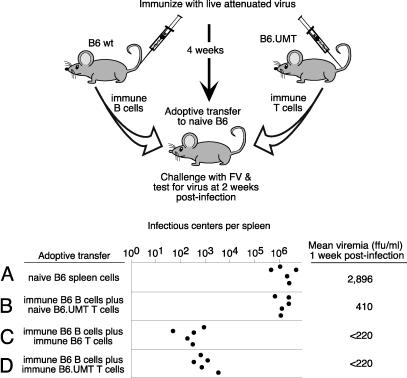Fig. 4.
Protection by adoptive transfer. B6 and B6.UMT mice were immunized with live attenuated virus. After 1 month, immune B cells from the B6 mice and immune T cells from the B6.UMT mice were purified from spleen and transferred to naive B6 mice. The next day, the recipient mice were challenged with FV. ICs were determined at 2 weeks after infection. Recipient mice were all wild-type B6 mice. Group A received 5 × 107 nucleated spleen cells from naive B6 mice. The other groups received 2 × 107 CD19+ B cells from immunized B6 mice and one of the following: group B, 2 × 107 T cells from naive B6.UMT mice; group C, 2 × 107 T cells from immune B6 mice; and group D, 1.9 × 107 T cells from immune B6.UMT mice. The mice were infected with FV the day after adoptive transfer of the B and T cells. The limit of detection of the assay was 1 IC per 3 × 107 spleen cells. Each dot represents results from a single mouse. The purities of the cell populations were all >90%. Groups C and D, but not B, were statistically different from group A (P < 0.01 by ANOVA with Dunnett multiple-comparisons posttest). Groups C and D were not statistically different by Mann–Whitney U test (P = 0.0556).

